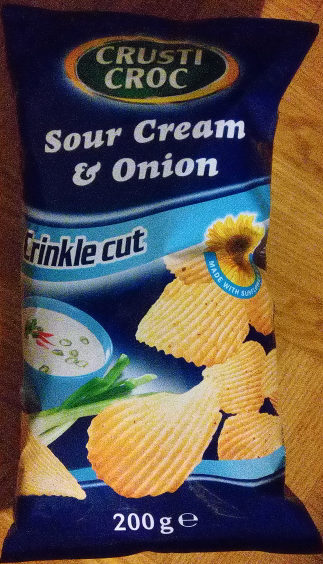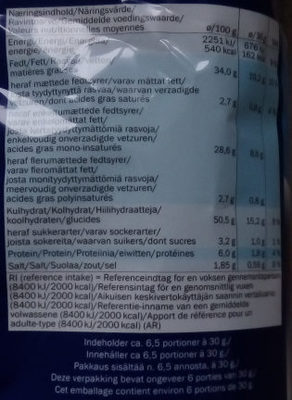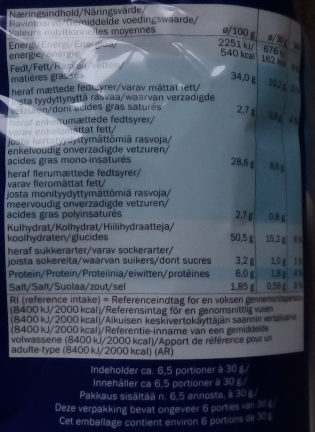Help us make food transparency the norm!
As a non-profit organization, we depend on your donations to continue informing consumers around the world about what they eat.
The food revolution starts with you!
Crusti Croc Sour Cream & Onion - 200 g
Crusti Croc Sour Cream & Onion - 200 g
Ambiguous barcode: This product has a Restricted Circulation Number barcode for products within a company. This means that different producers and stores can use the same barcode for different products.
×
This product page is not complete. You can help to complete it by editing it and adding more data from the photos we have, or by taking more photos using the app for Android or iPhone/iPad. Thank you!
×
Streckkod: 20250799
Vanligt namn: Räfflade potatischips med lök- och gräddfilssmak
Kvantitet: 200 g
Förpackning: Plast, en:pp-polypropylene
Varumärken: Crusti Croc, Lidl
Kategorier: Växtbaserad mat och dryck, Växtbaserad mat, Snacks, Spannmål och Potatisar, Salta snacks, Aptitretare, en:Chips and fries, en:Crisps, Potatischips, en:Flavoured potato crisps
Tillverknings eller bearbetningsplats: Germany
Butiker: Lidl
Länder där såld: Sverige
Matching with your preferences
Hälsa
Ingredienser
-
23 ingredienser
58% potatis, 34% solrosolja, salt, 1,4% lökpulver, vasslepulver (av mjölk), socker, laktos, smakförstärkare (mononatriumglutamat, dinatrium-5'-ribonukleotider), potatisstärkelse, syror (mjölksyra, äppelsyra, citronsyra), jästpulver, örtkryddor, jästextrakt, naturliga aromer, kryddor, surhetsreglerande medel (kalciumlaktat).Allergener: MjölkSpår: Selleri, Gluten, Soja
Food processing
-
Ultra processed foods
Elements that indicate the product is in the 4 - Ultra bearbetade livsmedel och drycker group:
- Tillsats: E327 - Kalciumlaktat
- Tillsats: E621 - Mononatriumglutamat
- Tillsats: E635 - Dinatrium-5'-ribonukleotider
- Ingrediens: Smakförstärkare
- Ingrediens: Arom
- Ingrediens: Laktos
- Ingrediens: Vassle
Food products are classified into 4 groups according to their degree of processing:
- Obearbetade eller minimalt bearbetade livsmedel
- Bearbetade kulinariska ingredienser
- Halvfabrikat
- Ultra processed foods
The determination of the group is based on the category of the product and on the ingredients it contains.
Tillsatser
-
E270 - Mjölksyra
Lactic acid: Lactic acid is an organic compound with the formula CH3CH-OH-COOH. In its solid state, it is white and water-soluble. In its liquid state, it is colorless. It is produced both naturally and synthetically. With a hydroxyl group adjacent to the carboxyl group, lactic acid is classified as an alpha-hydroxy acid -AHA-. In the form of its conjugate base called lactate, it plays a role in several biochemical processes. In solution, it can ionize a proton from the carboxyl group, producing the lactate ion CH3CH-OH-CO−2. Compared to acetic acid, its pKa is 1 unit less, meaning lactic acid deprotonates ten times more easily than acetic acid does. This higher acidity is the consequence of the intramolecular hydrogen bonding between the α-hydroxyl and the carboxylate group. Lactic acid is chiral, consisting of two optical isomers. One is known as L--+--lactic acid or -S--lactic acid and the other, its mirror image, is D--−--lactic acid or -R--lactic acid. A mixture of the two in equal amounts is called DL-lactic acid, or racemic lactic acid. Lactic acid is hygroscopic. DL-lactic acid is miscible with water and with ethanol above its melting point which is around 17 or 18 °C. D-lactic acid and L-lactic acid have a higher melting point. In animals, L-lactate is constantly produced from pyruvate via the enzyme lactate dehydrogenase -LDH- in a process of fermentation during normal metabolism and exercise. It does not increase in concentration until the rate of lactate production exceeds the rate of lactate removal, which is governed by a number of factors, including monocarboxylate transporters, concentration and isoform of LDH, and oxidative capacity of tissues. The concentration of blood lactate is usually 1–2 mM at rest, but can rise to over 20 mM during intense exertion and as high as 25 mM afterward. In addition to other biological roles, L-lactic acid is the primary endogenous agonist of hydroxycarboxylic acid receptor 1 -HCA1-, which is a Gi/o-coupled G protein-coupled receptor -GPCR-.In industry, lactic acid fermentation is performed by lactic acid bacteria, which convert simple carbohydrates such as glucose, sucrose, or galactose to lactic acid. These bacteria can also grow in the mouth; the acid they produce is responsible for the tooth decay known as caries. In medicine, lactate is one of the main components of lactated Ringer's solution and Hartmann's solution. These intravenous fluids consist of sodium and potassium cations along with lactate and chloride anions in solution with distilled water, generally in concentrations isotonic with human blood. It is most commonly used for fluid resuscitation after blood loss due to trauma, surgery, or burns.Källa: Wikipedia (Engelska)
-
E296 - Äppelsyra
Malic acid: Malic acid is an organic compound with the molecular formula C4H6O5. It is a dicarboxylic acid that is made by all living organisms, contributes to the pleasantly sour taste of fruits, and is used as a food additive. Malic acid has two stereoisomeric forms -L- and D-enantiomers-, though only the L-isomer exists naturally. The salts and esters of malic acid are known as malates. The malate anion is an intermediate in the citric acid cycle.Källa: Wikipedia (Engelska)
-
E327 - Kalciumlaktat
Calcium lactate: Calcium lactate is a white crystalline salt with formula C6H10CaO6, consisting of two lactate anions H3C-CHOH-CO−2 for each calcium cation Ca2+. It forms several hydrates, the most common being the pentahydrate C6H10CaO6·5H2O. Calcium lactate is used in medicine, mainly to treat calcium deficiencies; and as a food additive with E number of E327. Some cheese crystals consist of calcium lactate.Källa: Wikipedia (Engelska)
-
E330 - Citronsyra
Citric acid: Citric acid is a weak organic acid that has the chemical formula C6H8O7. It occurs naturally in citrus fruits. In biochemistry, it is an intermediate in the citric acid cycle, which occurs in the metabolism of all aerobic organisms. More than a million tons of citric acid are manufactured every year. It is used widely as an acidifier, as a flavoring and chelating agent.A citrate is a derivative of citric acid; that is, the salts, esters, and the polyatomic anion found in solution. An example of the former, a salt is trisodium citrate; an ester is triethyl citrate. When part of a salt, the formula of the citrate ion is written as C6H5O3−7 or C3H5O-COO-3−3.Källa: Wikipedia (Engelska)
-
E621 - Mononatriumglutamat
Monosodium glutamate: Monosodium glutamate -MSG, also known as sodium glutamate- is the sodium salt of glutamic acid, one of the most abundant naturally occurring non-essential amino acids. Glutamic acid is found naturally in tomatoes, grapes, cheese, mushrooms and other foods.MSG is used in the food industry as a flavor enhancer with an umami taste that intensifies the meaty, savory flavor of food, as naturally occurring glutamate does in foods such as stews and meat soups. It was first prepared in 1908 by Japanese biochemist Kikunae Ikeda, who was trying to isolate and duplicate the savory taste of kombu, an edible seaweed used as a base for many Japanese soups. MSG as a flavor enhancer balances, blends, and rounds the perception of other tastes.The U.S. Food and Drug Administration has given MSG its generally recognized as safe -GRAS- designation. A popular belief is that large doses of MSG can cause headaches and other feelings of discomfort, known as "Chinese restaurant syndrome," but double-blind tests fail to find evidence of such a reaction. The European Union classifies it as a food additive permitted in certain foods and subject to quantitative limits. MSG has the HS code 29224220 and the E number E621.Källa: Wikipedia (Engelska)
Ingrediensanalys
-
Palmoljefri
No ingredients containing palm oil detected
-
Icke-vegan
Non-vegan ingredients: Vasslepulver, Mjölk, Laktos
-
Kanske Vegetariskt
Ingredients that may not be vegetarian: E635, Naturlig arom
-
Details of the analysis of the ingredients
: potatis 58%, solrosolja 34%, salt, lök 1.4%, _vasslepulver_ (av _mjölk_), socker, _laktos_, smakförstärkare (mononatriumglutamat, dinatrium-5'-ribonukleotider), potatisstärkelse, syror (mjölksyra, äppelsyra, citronsyra), jästpulver, örtkryddor, jästextrakt, naturliga aromer, kryddor, surhetsreglerande medel (kalciumlaktat)- potatis -> en:potato - vegan: yes - vegetarian: yes - ciqual_food_code: 4003 - percent_min: 58 - percent: 58 - percent_max: 58
- solrosolja -> en:sunflower-oil - vegan: yes - vegetarian: yes - from_palm_oil: no - ciqual_food_code: 17440 - percent_min: 34 - percent: 34 - percent_max: 34
- salt -> en:salt - vegan: yes - vegetarian: yes - ciqual_food_code: 11058 - percent_min: 1.4 - percent_max: 6.6
- lök -> en:onion - vegan: yes - vegetarian: yes - ciqual_food_code: 20034 - percent_min: 1.4 - percent: 1.4 - percent_max: 1.4
- _vasslepulver_ -> en:whey-powder - vegan: no - vegetarian: maybe - percent_min: 0 - percent_max: 1.4
- av _mjölk_ -> en:milk - vegan: no - vegetarian: yes - ciqual_proxy_food_code: 19051 - percent_min: 0 - percent_max: 1.4
- socker -> en:sugar - vegan: yes - vegetarian: yes - ciqual_proxy_food_code: 31016 - percent_min: 0 - percent_max: 1.4
- _laktos_ -> en:lactose - vegan: no - vegetarian: yes - percent_min: 0 - percent_max: 1.4
- smakförstärkare -> en:flavour-enhancer - percent_min: 0 - percent_max: 1.1
- mononatriumglutamat -> en:e621 - vegan: yes - vegetarian: yes - percent_min: 0 - percent_max: 1.1
- dinatrium-5'-ribonukleotider -> en:e635 - vegan: maybe - vegetarian: maybe - percent_min: 0 - percent_max: 0.55
- potatisstärkelse -> en:potato-starch - vegan: yes - vegetarian: yes - ciqual_proxy_food_code: 9510 - percent_min: 0 - percent_max: 0.942857142857142
- syror -> en:acid - percent_min: 0 - percent_max: 0.825
- mjölksyra -> en:e270 - vegan: yes - vegetarian: yes - percent_min: 0 - percent_max: 0.825
- äppelsyra -> en:e296 - vegan: yes - vegetarian: yes - percent_min: 0 - percent_max: 0.4125
- citronsyra -> en:e330 - vegan: yes - vegetarian: yes - percent_min: 0 - percent_max: 0.275
- jästpulver -> en:yeast-powder - vegan: yes - vegetarian: yes - percent_min: 0 - percent_max: 0.733333333333333
- örtkryddor -> en:herb - vegan: yes - vegetarian: yes - percent_min: 0 - percent_max: 0.66
- jästextrakt -> en:yeast-extract - vegan: yes - vegetarian: yes - percent_min: 0 - percent_max: 0.6
- naturliga aromer -> en:natural-flavouring - vegan: maybe - vegetarian: maybe - percent_min: 0 - percent_max: 0.55
- kryddor -> en:spice - vegan: yes - vegetarian: yes - percent_min: 0 - percent_max: 0.507692307692307
- surhetsreglerande medel -> en:acidity-regulator - percent_min: 0 - percent_max: 0.471428571428571
- kalciumlaktat -> en:e327 - vegan: yes - vegetarian: yes - percent_min: 0 - percent_max: 0.471428571428571
Näring
-
Poor nutritional quality
⚠ ️Varning: mängden fibrer är inte angiven, eventuella positiv inverkan på betyget kunde inte beaktas.This product is not considered a beverage for the calculation of the Nutri-Score.
Positiva poäng: 0
- Proteiner: 3 / 5 (värde: 6, avrundat värde: 6)
- Fiber: 0 / 5 (värde: 0, avrundat värde: 0)
- Frukt, grönsaker, nötter och raps- / valnöt- / olivoljor: 0 / 5 (värde: 0, avrundat värde: 0)
Negativa poäng: 16
- Energi: 6 / 10 (värde: 2251, avrundat värde: 2251)
- Socker: 0 / 10 (värde: 3.2, avrundat värde: 3.2)
- Mättat fett: 2 / 10 (värde: 2.7, avrundat värde: 2.7)
- Natrium: 8 / 10 (värde: 740, avrundat värde: 740)
The points for proteins are not counted because the negative points are greater or equal to 11.
Näringsvärde: (16 - 0)
Nutri-Score:
-
Näringsvärden
-
Fett i hög kvantitet (34%)
What you need to know- A high consumption of fat, especially saturated fats, can raise cholesterol, which increases the risk of heart diseases.
Recommendation: Limit the consumption of fat and saturated fat- Choose products with lower fat and saturated fat content.
-
Mättat fett i måttlig kvantitet (2.7%)
What you need to know- A high consumption of fat, especially saturated fats, can raise cholesterol, which increases the risk of heart diseases.
Recommendation: Limit the consumption of fat and saturated fat- Choose products with lower fat and saturated fat content.
-
Sockerarter i låg kvantitet (3.2%)
What you need to know- A high consumption of sugar can cause weight gain and tooth decay. It also augments the risk of type 2 diabetes and cardio-vascular diseases.
Recommendation: Limit the consumption of sugar and sugary drinks- Sugary drinks (such as sodas, fruit beverages, and fruit juices and nectars) should be limited as much as possible (no more than 1 glass a day).
- Choose products with lower sugar content and reduce the consumption of products with added sugars.
-
Salt i hög kvantitet (1.85%)
What you need to know- A high consumption of salt (or sodium) can cause raised blood pressure, which can increase the risk of heart disease and stroke.
- Many people who have high blood pressure do not know it, as there are often no symptoms.
- Most people consume too much salt (on average 9 to 12 grams per day), around twice the recommended maximum level of intake.
Recommendation: Limit the consumption of salt and salted food- Reduce the quantity of salt used when cooking, and don't salt again at the table.
- Limit the consumption of salty snacks and choose products with lower salt content.
-
-
Näringsfakta
Näringsfakta Som såld
för 100 g / 100 mlSom såld
per portion (30 g)Compared to: en:Flavoured potato crisps Energi 2 251 kj
(538 kcal)675 kj
(161 kcal)+3 % Fett 34 g 10,2 g +6 % Mättat fett 2,7 g 0,81 g −7 % Enkelomättat fett 28,6 g 8,58 g Fleromättat fett 2,7 g 0,81 g Kolhydrat 50,5 g 15,2 g −5 % Sockerarter 3,2 g 0,96 g +35 % Fiber ? ? Protein 6 g 1,8 g +6 % Salt 1,85 g 0,555 g +19 % Fruits‚ vegetables‚ nuts and rapeseed‚ walnut and olive oils (estimate from ingredients list analysis) 0 % 0 %
Miljö
-
Eco-Score B - Låg miljöpåverkan
The Eco-Score is an experimental score that summarizes the environmental impacts of food products.→ The Eco-Score was initially developped for France and it is being extended to other European countries. The Eco-Score formula is subject to change as it is regularly improved to make it more precise and better suited to each country.Life cycle analysis
-
Average impact of products of the same category: A (Score: 87/100)
Kategori: Potato crisps
Kategori: Potato crisps
- PEF environmental score: 0.22 (the lower the score, the lower the impact)
- including impact on climate change: 1.54 kg CO2 eq/kg of product
Stage Impact Jordbruk
62.8 %Bearbetar
17.3 %Förpackning
10.6 %Transportation
7.1 %Distribution
2.2 %Consumption
0.0 %
Bonuses and maluses
-
Missing origins of ingredients information
Malus: -5
⚠ ️ The origins of the ingredients of this product are not indicated.
If they are indicated on the packaging, you can modify the product sheet and add them.
If you are the manufacturer of this product, you can send us the information with our free platform for producers.
-
Packaging with a medium impact
Malus: -8
Form Material Återvinning Impact Okänd PP 5 - polypropen Hög ⚠ ️ The information about the packaging of this product is not sufficiently precise (exact shapes and materials of all components of the packaging).⚠ ️ For a more precise calculation of the Eco-Score, you can modify the product page and add them.
If you are the manufacturer of this product, you can send us the information with our free platform for producers.
Eco-Score for this product
-
Impact for this product: B (Score: 74/100)
Produkt: Crusti Croc Sour Cream & Onion - 200 g
Life cycle analysis score: 87
Sum of bonuses and maluses: -13
Final score: 74/100
-
Carbon footprint
-
Equal to driving 0.8 km in a petrol car
154 g CO² per 100g of product
The carbon emission figure comes from ADEME's Agribalyse database, for the category: Potato crisps (Source: ADEME Agribalyse Database)
Stage Impact Jordbruk
53.5 %Bearbetar
15.0 %Förpackning
18.2 %Transportation
11.9 %Distribution
1.3 %Consumption
0.0 %
Förpackning
-
Packaging with a medium impact
-
Packaging parts
(PP 5 - polypropen)
-
Packaging materials
Material % Packaging weight Packaging weight per 100 g of product Plast
-
Transportation
-
Origins of ingredients
Missing origins of ingredients information
⚠ ️ The origins of the ingredients of this product are not indicated.
If they are indicated on the packaging, you can modify the product sheet and add them.
If you are the manufacturer of this product, you can send us the information with our free platform for producers.Add the origins of ingredients for this product Add the origins of ingredients for this product
Report a problem
-
Incomplete or incorrect information?
Category, labels, ingredients, allergens, nutritional information, photos etc.
If the information does not match the information on the packaging, please complete or correct it. Open Food Facts is a collaborative database, and every contribution is useful for all.
Datakällor
Produkt tillagd den av olofolleola4
Senast ändrad produktsida på av packbot.
Produktsida också redigerad av openfoodfacts-contributors.











